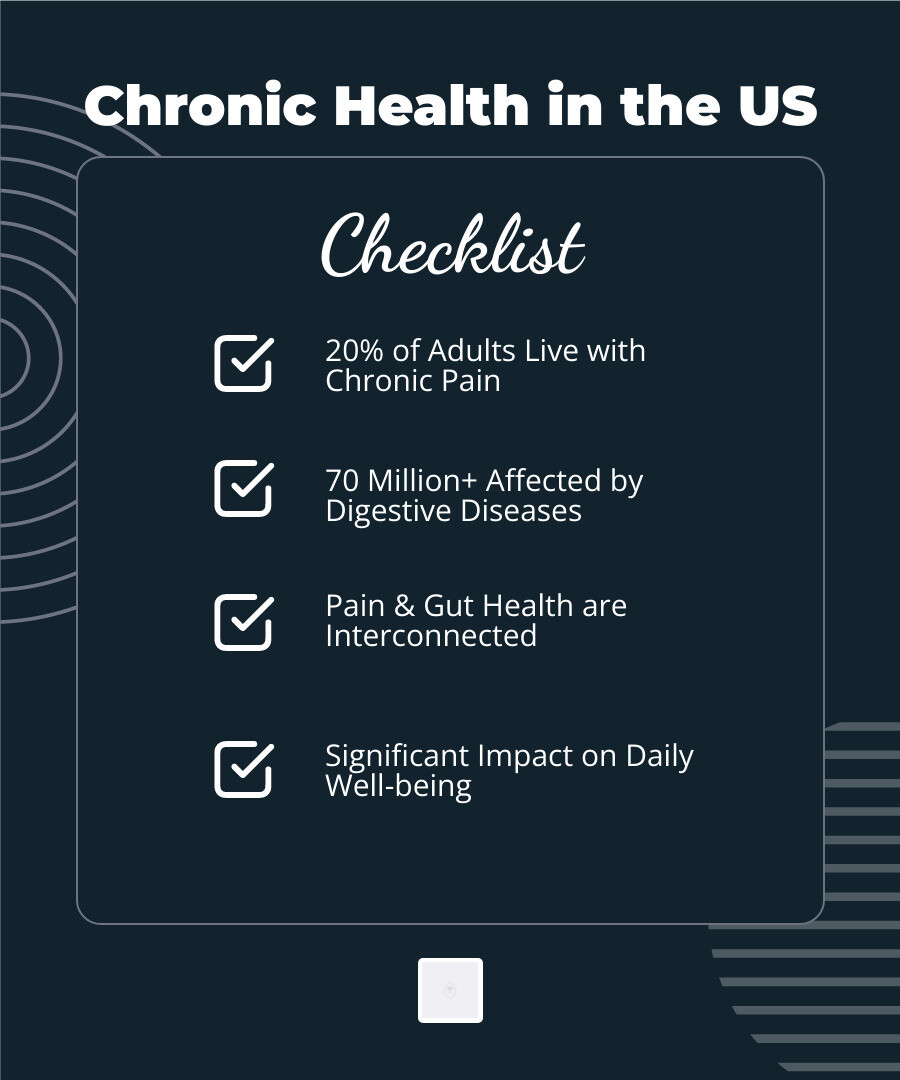
Introduction: The Growing Need for Chronic Health Management
Living with chronic health issues can be a challenging journey. Many individuals face persistent pain or ongoing digestive problems, often impacting their daily lives. We understand these struggles deeply.
As specialists in interventional pain management and gastroenterology, we have seen the complexities of long-term conditions. Chronic disease is prevalent, and effective management goes beyond simple symptom relief. It involves a holistic approach to improve overall well-being. For instance, managing chronic lumbar (low back) pain often requires dedicated strategies. Understanding advanced chronic lumbar health management is crucial for lasting relief and improved function.
Chronic Health Management is about proactive, ongoing care that empowers patients to take control of their health. It addresses the interconnectedness of body systems. We often find a significant link between pain and digestive health, where one can influence the other.

The Patient-Centered Approach
Our approach always prioritizes the patient’s needs. We believe in empowering individuals to take an active role in their health journey. This means fostering collaborative care, where we work together to set realistic goals. Our focus shifts from merely curing conditions to effectively managing them, enhancing your quality of life. We aim to equip you with the knowledge and tools for long-term success.

Understanding the Foundations of Managing Chronic Conditions
Effectively managing chronic conditions, whether they manifest as persistent pain or digestive distress, hinges on a comprehensive and integrated approach. We recognize that these conditions rarely exist in isolation; a complex interplay of physical, psychological, and social factors often influences them. This understanding forms the bedrock of what we call a multidisciplinary team approach. Such a team typically includes physicians, physical therapists, nutritionists, psychologists, and other specialists who collaborate to provide holistic care.
Patient education is paramount in this model. We believe that informed patients are empowered patients. Understanding the nature of your condition, the rationale behind treatment strategies, and the expected outcomes allows you to become an active participant in your healing process. This knowledge empowers individuals to develop self-management strategies, enabling them to take control of their daily health decisions, from medication adherence to lifestyle choices.
The role of psychosocial factors cannot be overstated. Chronic pain, for example, is heavily influenced by beliefs, emotions, and social support. Fear-avoidance beliefs, where individuals limit activity due to fear of pain or re-injury, can inadvertently worsen their condition by leading to deconditioning and increased disability. Similarly, stress and its impact on both pain perception and digestive function are well-documented. Chronic stress can exacerbate symptoms, create a vicious cycle, and hinder recovery. Addressing these factors through psychological support and coping mechanisms is an integral part of comprehensive care.
The Importance of Accurate Diagnosis
Before any effective management plan can be implemented, an accurate diagnosis is essential. This process begins with diagnostic triage, a systematic evaluation that classifies the patient’s condition and rules out serious underlying pathologies. For lumbar pain, this means carefully screening for “red flags” – symptoms that may indicate a more serious condition, such as a fracture, infection, or tumor, which would require immediate medical attention.
In the context of low back pain, we often differentiate between specific and non-specific conditions. While particular conditions (like a herniated disc with sciatica, spinal stenosis, or inflammatory arthritis) have an identifiable cause, non-specific low back pain accounts for over 90% of patients presenting to primary care. This latter category, though lacking a clear anatomical diagnosis, is no less real or debilitating. The goal of diagnosis is not always to pinpoint a precise structural anomaly, but rather to understand the patient’s presentation, identify contributing factors, and guide appropriate, personalized treatment. This careful diagnostic process forms the foundation for a personalized plan that addresses the individual’s unique needs and circumstances.
Core Components of Effective Chronic Health Management
Effective chronic health management is built upon several interconnected pillars, each contributing to a patient’s overall well-being and long-term success. We integrate these components into our treatment philosophy:
- Assessment: A thorough initial and ongoing evaluation of physical, psychological, and social factors influencing the condition. This includes understanding pain patterns, functional limitations, emotional distress, and lifestyle habits.
- Education: Providing patients with comprehensive information about their condition, treatment options, prognosis, and self-management techniques. This empowers them to make informed decisions and actively participate in their care.
- Active Therapies: Engaging patients in treatments that require their active participation, such as physical therapy exercises, movement retraining, and graded activity. These therapies build strength, improve function, and reduce fear.
- Lifestyle Modification: Guiding patients toward healthier habits, including balanced nutrition, regular physical activity, adequate sleep, and stress reduction techniques. These modifications are crucial for overall health and symptom management.
- Psychological Support: Addressing the emotional and cognitive aspects of chronic conditions through counseling, cognitive behavioral therapy (CBT), mindfulness, or other psychological interventions. This helps manage pain perception, cope with stress, and overcome fear-avoidant behaviors.
By focusing on these core components, we aim to equip our patients with the tools they need to manage their chronic conditions effectively and enhance their quality of life.
A Deep Dive into Chronic Pain: The Case of Lumbar Pain
Lumbar pain, commonly known as low back pain (LBP), is an incredibly prevalent condition, affecting nearly 60-80% of people throughout their lifetime. It’s a leading cause of disability worldwide and a frequent reason for physician visits. Understanding this condition is crucial for effective management.

We define lumbar pain as discomfort localized below the costal margin (bottom of the rib cage) and above the inferior gluteal folds, with or without pain radiating into the leg. When this pain persists for 12 weeks or longer, it is classified as chronic low back pain. This distinction is important because acute (less than 6 weeks) and subacute (6-12 weeks) pain often resolve on their own, with 50% recovering within 2 weeks and 70% within 1 month without specific treatment. However, nearly a third of those seeking treatment for an acute episode will experience persistent moderate pain for a year. Up to 23% of the world’s adults suffer from chronic LBP, and it’s estimated that seven million adults in the United States have activity limitations as a result.
Common causes and risk factors for lumbar pain are diverse. While specific causes like herniated discs, spinal stenosis, fractures, or inflammatory conditions exist, over 90% of cases are non-specific, meaning no precise anatomical cause can be identified. Risk factors can be physical, psychological, and social, including sedentary lifestyles, obesity, heavy lifting, poor posture, stress, anxiety, depression, and job dissatisfaction. A recent systematic review even demonstrated an annual rate of adolescents suffering from back pain of 11.8% to 33%, highlighting its widespread impact across age groups.
The Role of Physical Therapy in Pain Management
Physical therapy (PT) plays a pivotal role in the management of lumbar pain, particularly for non-specific cases and as a primary non-pharmacological intervention. Our goal in PT is not just to alleviate pain but to restore function, improve mobility, and empower patients with self-management strategies.
The process typically begins with thorough assessment strategies. A physical therapist will conduct a detailed health history, evaluate your symptoms, assess range of motion, strength, posture, and gait. This evaluation helps identify potential red flags and pinpoint specific movement patterns or impairments that may be contributing to your pain. Psychosocial factors, such as fear-avoidance beliefs and catastrophizing, are also screened for, as they significantly influence pain experience and recovery.
One of the most impactful developments in PT for LBP is the use of stratified care models. These models, such as the STarT Back Screening Tool, categorize patients based on their risk of developing chronic pain (low, medium, or high risk). This allows us to tailor treatment intensity and approach to the individual’s prognosis, ensuring that those who require more intensive intervention receive it, while avoiding over-treatment for those who are likely to recover quickly. This individualized approach is crucial to achieving optimal outcomes.
For an overview of evidence-based physical therapy programs, we often incorporate a range of techniques. These include:
- Manual Therapy: Hands-on techniques such as joint mobilizations (thrust and non-thrust), soft tissue mobilization, and massage are used to reduce pain, improve tissue extensibility, and restore joint mechanics. These are typically used as an adjunct to active exercise.
- The McKenzie Method (Mechanical Diagnosis and Therapy – MDT): This approach focuses on identifying a “directional preference” – specific movements or positions that centralize (move away from the extremities) or abolish pain. It empowers patients through self-treatment exercises based on their individual responses.
- Motor Control Exercises: These exercises focus on retraining the deep core muscles (like the transversus abdominis and multifidus) to provide segmental stability to the lumbar spine. The goal is to improve the coordination and endurance of these muscles, which can become inhibited in the presence of pain.
- Therapeutic Exercise: A broad category encompassing various exercises designed to improve strength, flexibility, endurance, and balance, custom to the patient’s specific needs and goals.
Current clinical guidelines, such as those from the American College of Physicians (ACP), strongly recommend non-invasive, non-pharmacological approaches, including physical therapy, as first-line treatments for acute, sub-acute, and chronic low back pain. These guidelines emphasize active approaches over passive modalities alone. Physical therapists are at the forefront of implementing these guidelines, providing care that is both evidence-based and patient-centered.
Building a Self-Management Toolkit for Back Pain
Beyond in-clinic treatments, a crucial aspect of physical therapy for lumbar pain is empowering patients to build a robust self-management toolkit. This involves a combination of prescribed exercise programs, ergonomic adjustments, lifestyle modifications, and education aimed at preventing recurrence.

Prescribed Exercise Programs: These are customized to individual needs, focusing on:
- Flexibility: Stretches for the hamstrings, hip flexors, piriformis, and lumbar rotators help restore the normal range of motion and reduce muscle tightness. Examples include single knee-to-chest, double knees-to-chest, and lower trunk rotations.
- Core Stabilization: Exercises that engage the deep abdominal and back muscles to support the spine. This includes movements like pelvic tilts, bird-dog, planks, and dead bugs. The goal is to improve the endurance and control of these muscles, creating a stable base for movement.
- Strengthening: Targeting major muscle groups, including the hips, glutes, and quadriceps, is essential. Exercises like squats, bridges, lunges, and step-ups build overall strength, which can offload stress on the lumbar spine. Strengthening the gluteus medius, for instance, through side steps, helps stabilize the pelvis and prevent compensatory movements that strain the back.
Exercise programs are typically structured with a gradual progression in frequency, intensity, and duration. A physical therapist will guide you on appropriate repetitions and sets, ensuring proper form to maximize benefits and minimize risk. For example, start with five repetitions and gradually build to 30 for exercises like bridges or lower back flexibility movements. Physical exercise is recommended to prevent the consequences of low back pain, such as absence from work and the occurrence of further episodes.
Ergonomics and Lifestyle Modification: How we interact with our environment daily significantly impacts our back health.
- Workstation Ergonomics: Adjusting chair height, monitor placement, and keyboard position to maintain a neutral spine can prevent strain. Regular breaks to stand and move are also vital.
- Lifting Techniques: Learning to lift with your legs, keeping the load close to your body, and avoiding twisting movements protects the spine.
- Daily Habits: Simple changes, such as maintaining a standing pelvic tilt throughout the day, using a sit-to-stand desk, or incorporating short walking breaks, can make a significant difference.
Prevention of Recurrence: The ultimate goal of physical therapy is not just pain relief but also long-term prevention. This involves:
- Continued Exercise: Maintaining a regular exercise routine, even after pain subsides, is critical.
- Self-Awareness: Learning to recognize early warning signs of pain and addressing them promptly with self-management techniques.
- Pain Neuroscience Education: Understanding that pain is complex and not always indicative of tissue damage can reduce fear and promote activity.
- Stress Management: Implementing techniques like mindfulness, meditation, or deep breathing to mitigate the impact of stress on the body.
While physical therapy is highly effective, it’s important to be aware of contraindications and precautions. For example, certain exercises may be modified or avoided in cases of acute disc herniation, spinal instability, or specific neurological deficits. A qualified physical therapist will conduct a thorough assessment to ensure your program is safe and appropriate. They will also guide you on when to stop an exercise if it causes sharp or radiating pain.
By actively engaging in these strategies, patients can significantly reduce their risk of recurrence of lumbar pain and maintain a healthy, active lifestyle.
Parallels in Digestive Health: Managing Chronic GI Disorders
Just as with chronic lumbar pain, managing chronic gastrointestinal (GI) disorders requires a nuanced and integrated approach. These conditions, such as Irritable Bowel Syndrome (IBS), Inflammatory Bowel Disease (IBD), and Gastroesophageal Reflux Disease (GERD), can significantly diminish quality of life and often present with a complex array of symptoms.

We understand that the digestive system is far more intricate than a simple tube; it’s a sophisticated network influenced by diet, lifestyle, stress, and even our mental state. A key concept here is the gut-brain axis, a bidirectional communication system that links the central nervous system with the enteric nervous system of the gut. This connection explains why emotional stress can trigger digestive symptoms and why gut issues can impact mood.
Trigger identification is a critical step in managing chronic GI disorders. This involves carefully tracking dietary intake, stress levels, activity, and symptoms to pinpoint specific foods, situations, or habits that exacerbate the condition. This process often requires patience and meticulous record-keeping, but it empowers patients to take proactive steps in managing their symptoms.
A Holistic Strategy for Digestive Wellness
Our approach to digestive wellness is inherently holistic, mirroring the comprehensive strategies we employ for chronic pain. We recognize that true well-being stems from addressing the body as an interconnected system.
Dietary Interventions: Nutrition plays a foundational role. Depending on the specific GI condition, this might involve:
- Elimination Diets: For example, the low-FODMAP diet for IBS, which helps identify and remove trigger foods.
- Anti-inflammatory Diets: For IBD, focus on whole, unprocessed foods rich in antioxidants and healthy fats.
- GERD-Specific Diets: Avoiding common reflux triggers, such as spicy foods, caffeine, and fatty meals. The role of nutritionists is invaluable in this context, as they can provide personalized guidance to ensure nutritional adequacy while managing symptoms.
Stress Reduction Techniques: Given the strong gut-brain axis, managing stress is non-negotiable for digestive health. Techniques we often recommend include:
- Mindfulness and Meditation: To cultivate present-moment awareness and reduce anxiety.
- Deep Breathing Exercises: To activate the parasympathetic nervous system, promoting “rest and digest” functions.
- Yoga and Tai Chi: Gentle movements combined with breathwork can be highly effective.
Sleep Hygiene: Adequate, restorative sleep is crucial for gut repair and overall health. We encourage consistent sleep schedules, a comfortable sleep environment, and avoiding screens before bedtime.
The Importance of Regular, Gentle Exercise: Physical activity benefits digestion by promoting gut motility, reducing stress, and improving overall circulation. For individuals with gastrointestinal issues, gentle exercises such as walking, swimming, or light yoga are often recommended. These activities can help alleviate constipation, reduce bloating, and contribute to a sense of well-being without causing undue stress on the digestive system.
Addressing Systemic Complications
Chronic GI disorders can sometimes lead to systemic complications that require careful attention. For example, conditions like Crohn’s disease or celiac disease can cause malabsorption issues, where the body struggles to absorb essential nutrients from food. This can lead to various nutritional deficiencies, which in turn impact overall health and energy levels.
One common and significant complication, particularly in IBD, is anemia. Chronic inflammation and blood loss in the GI tract can lead to iron deficiency anemia, which manifests as fatigue, weakness, and shortness of breath. Recognizing and managing these deficiencies is a critical part of comprehensive care. For those seeking additional support and GastroDoxs chronic anemia management, specialized gastroenterology practices offer targeted interventions and ongoing monitoring.
Regular monitoring is crucial. This includes routine blood tests to check for nutritional deficiencies, inflammatory markers, and overall health status. For IBD patients, regular endoscopic evaluations may be necessary to monitor disease activity and adjust treatment plans. This proactive monitoring allows us to address complications early, prevent further health decline, and optimize long-term outcomes. We work closely with our patients to create a personalized monitoring schedule that keeps them healthy and informed.
Conclusion: Integrating Strategies for Whole-Person Health
Navigating complex health issues like chronic lumbar pain and digestive disorders can feel overwhelming. Still, our experience as specialists in both interventional pain management and gastroenterology has shown us a clear path forward: an integrated, patient-centered approach to whole-person health.
We’ve explored how seemingly disparate conditions often share underlying mechanisms, from the profound impact of psychosocial factors, such as stress and fear-avoidance beliefs, to the crucial role of inflammation and nutrient absorption. Just as physical therapy empowers individuals with lumbar pain through custom exercises, manual therapy, and education to manage symptoms and prevent recurrence, a holistic strategy for digestive wellness employs dietary interventions, stress reduction, and gentle exercise to foster gut health and alleviate discomfort.
The interconnectedness of pain, digestion, and mental well-being is undeniable. A flare-up in one area can easily exacerbate another, creating a challenging cycle. Our goal is to break these cycles by equipping you with a comprehensive toolkit. This means understanding your body, actively participating in your treatment, and making informed lifestyle choices. Whether it’s building core strength to support your spine or identifying dietary triggers for your gut, every step you take contributes to your overall resilience.
We believe in an empowering message for patients: you are not merely a passive recipient of care. By embracing patient education, self-management strategies, and collaborative care with a multidisciplinary team, you take an active role in shaping your health journey. The future of chronic care lies in this integrated model, where specialists work hand in hand to address the full spectrum of your health needs, leading to not just symptom relief but a significantly improved quality of life.
Throughout the year, our writers feature fresh, in-depth, and relevant information for our audience of 40,000+ healthcare leaders and professionals. As a healthcare business publication, we cover and cherish our relationship with the entire health care industry including administrators, nurses, physicians, physical therapists, pharmacists, and more. We cover a broad spectrum from hospitals to medical offices to outpatient services to eye surgery centers to university settings. We focus on rehabilitation, nursing homes, home care, hospice as well as men’s health, women’s heath, and pediatrics.
Disclaimer: The content on this site is for general informational purposes only and is not intended as medical, legal, or financial advice. No content published here should be construed as a substitute for professional advice, diagnosis, or treatment. Always consult with a qualified healthcare or legal professional regarding your specific needs.
See our full disclaimer for more details.







